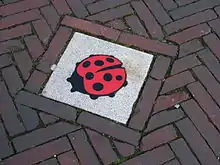Senseless violence
Senseless violence or zinloos geweld (Dutch) is a term frequently used by among others the media, politicians and NGOs to define the nature of several shocking events in Belgium and the Netherlands in recent years. The use of the term is politically charged and may not reflect any unique elements of any particular crime given that label.

The term expresses the perceived senselessness of the occurred acts of violence; the perpetrator and the victim do not know each other, the violence seems not to be motivated by greed or other common factors. The violence occurs suddenly and often under the influence of alcohol.
Origin of the term
The term "senseless violence", in the meaning used in this article, was first used in 1997 by Cees Bangma, district chief of the Dutch police unit Midden-Friesland. Before 1997 the term did not carry the same moral connotation in Belgian and Dutch culture, and typically referred to overseas warzone violence. Bangma used it in a letter written to the Leeuwarder Courant, a Frisian newspaper in which he made an appeal to the Dutch population to have a minute of silence for Meindert Tjoelker, who was killed on 13 September 1997. This minute was necessary "to make it clear to everyone that the Frisian society does not accept senseless violence". A wave of reactions followed, which also included media hype. As a consequence, much more attention was spent to every similar case of violence, which led to the perception that violence was on the increase.
A political group Landelijke Stichting Tegen Zinloos Geweld (national foundation against senseless violence) was created and people created the lady bug tile as a memorial or reminder against senseless violence. The group send guest teachers to schools and sport associations, but became rather inactive since ca. 2009.
Criticism
The term is often criticized. Some people think that violence is never legitimate and consider the term to be a tautology. Others say that the term has never been clearly defined and does not help to understand a particular phenomenon. Others point out that the term is or can be misused by politicians who strive for more repressive measures against crimes.
In 2016, the national newspaper NRC reported about a recent case of youngsters mistreating a homeless person. The newspaper quoted a spokesperson of the police who said that hardly any violence happens out of the blue. Criminologists have started to use the term uitgaansgeweld instead, violence occurring going out in the evening to pubs and bars. Because of the local approach there are no recent national figures about the phenomenon, according to an expert.[1]
Belgium
While there have been multiple isolated cases of fatal senseless violence in the decade since 1997, the number of deadly incidents surged since April in 2006. The following is a non-exhaustive list of deadly incidents since 1998:
- November 28, 1998: Patrick Mombaerts (died in Brussels after being beaten by very young robbers, who were sentenced to community service only).
- March 25, 1999: Christel De Jonghe (killed by a never uncovered immigrant during a robbery in Antwerp).
- April 2002: unidentified woman (died of a heart attack after being chased and attacked by youths in Brussels).
- May 7, 2002: Ahmed Isnasni and Habiba El Hajji (shot to death in Brussels by their neighbour Hendrik Vyt, who then killed himself).
- October 2002: unidentified elderly woman (died from wounds suffered in a street robbery in Brussels).
- November 26, 2002: Mohammed Achrak (shot to death in Antwerp by his neighbour; murder led to citywide riots).
- December 19, 2003: Glenn Wijnants (stabbed to death in Antwerp by a man for no apparent reason).
- April 12, 2006: Joe Van Holsbeeck (stabbed to death by two young during a daytime robbery in Brussels).
- May 11, 2006: Oulemata Niangadou and Luna Drowart (shot and killed by Hans Van Themsche during a homicidal rampage in Antwerp).
- June 24, 2006: Guido Demoor (train-driver who died after a hit against his head on an Antwerp bus by six youths he had asked to calm down).[2]
- July 2, 2006: Philibert Mees (stabbed to death in his Mechelen house by his neighbour).
- October 21, 2006: Eddy Sabbe (beaten to death during a robbery by immigrants).
- November 3, 2006: Mohamed Benzil (killed after being pushed in front of an Antwerp tram by immigrants, possibly in a case of road rage).
- February 3, 2007: Bart Bonroy (18-year-old stabbed to death in Ostend by Kenny B. after he refused to give a cigarette).
- February 20, 2007: Yannick Amba-Bongelo (17-year-old Congolese who was stabbed to death by a gang of 30 youths during Mardi Gras in Binche).
- September 1, 2007: yet unnamed elderly man (stabbed to death in broad daylight in a busy street in Brussels by a 28-year-old man).
- December 4, 2007: Kitty Van Nieuwenhuyse (23-year-old police officer shot to death in her patrol car when responding to a burglary).
- April, 2012: An MIVB employee died after being struck by a man, leading to a multiple-day-long strike by the Brussels transport services.[3]
Netherlands
- August 21, 1983: Kerwin Duinmeijer (stabbed to death in a racism related case)
- October 22, 2002: René Steegmans (beaten to death after asking respect for an elderly lady)
- December 2, 2012: Richard Nieuwenhuizen (fatally injured after serving as a volunteer linesman at a youth football match in Almere)
See also
References
- "'Zinloos geweld', bestaat dat nog?". NRC (in Dutch). Retrieved 2018-09-11.
- "deredactie.be".
- "ACV DE LIJN OOST-VLAANDEREN". acv-delijn-gent.blogspot.com.